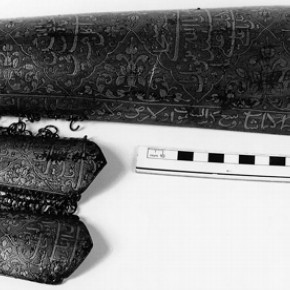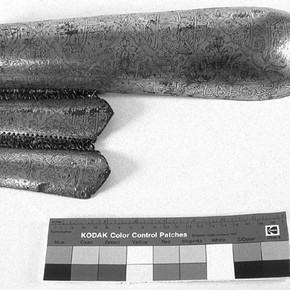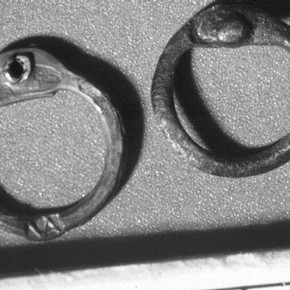Conservation Journal
Spring 2001 Issue 37
The Treatment of Mail on an Arm Guard from the Armoury of the Shah Shuja: Ethical Repair and in situ Documentation in Miniature
Large quantities of mail can be found in museum collections all over the world. Despite this, it can be difficult to date and attribute a place of origin. This means that any work carried out by a conservator or restorer must be documented in a way that will not interfere with the future study of mail. The treatment of this particular piece of armour illustrates how structural repairs, needed to preserve the object, can be undertaken without compromising historical information or future examination.
Mail and armour made of ferrous plates inter-connected with mail, were common types of armour used throughout the Indian sub-continent and the East 1 . Mail is constructed 2 of inter-linked metal rings, of which there are three main types: riveted closed; solid links (with no visible join) combined with alternate rows of riveted links; and butted links. The superficial similarity of mail from any period or culture, the lack of makers marks and its ability to be traded and re-used, has discouraged the study of this type of armour. Current study 3 is centred on mail armour, which can be dated and /or has a sound provenance. It is hoped that by building up a database of such examples the wider classification of mail armour can progress.
The arm guard (dastana) is such a key piece, being both dated and attributed to an armoury. It is constructed of three iron or steel plates overlaid with silver and gold decoration. The plates are connected by two strips of three rows of riveted and solid link mail. The main plate is dated 4 in gold overlay AH 1146 (1733-4 AD). It was sold to the V&A in 1904 by a Mr. G.H Thomas who claimed that it was acquired in India from the armoury of Shah Shuja 5 of Afghanistan. The object was selected for inclusion in the exhibition 'The Arts of the Sikh Kingdoms' because of its provenance and history.
Condition
The arm guard (figure 1) was covered in a thick coating of old degraded lacquer, which obscured much of the fine gold and silver overlay. This overlay was damaged with numerous rust spots pushing up or covering the gold and silver decoration. The most serious deterioration was to the mail. The two side plates of the arm guard were only connected to each other by eleven out of twenty-nine possible links. Worse than this, the side plates were just hanging on to the main plate by five damaged links. The side plates and most of the mail were in danger of becoming detached altogether. The lacquer coating was binding the links of mail together and holding them onto the plates, which ironically was responsible for saving some of the links from loss.
Treatment Proposal
An assessment was undertaken to decide on a suitable treatment. This assessment had to take into consideration the fact that the object had been selected for display at an international exhibition: It therefore needed to be structurally sound to travel. Of most concern was the fragility of the mail and the danger of the side plates becoming detached. It was apparent that a treatment just to stabilize the metal surfaces would not be enough in this case. Without repair the arm guard would be vulnerable to further damage and loss. With this in mind a treatment proposal was devised.
The suggested proposal was to first stabilize the metal surfaces and then to repair the mail using new links. This would increase the physical stability of the object, and allow it to be included in the exhibition. Re-attachment of the side plates would also improve the visual understanding of the object. (Figure 1). This proposal was discussed and agreed with S. Stronge, the Curator of the exhibition, although concerns were raised about the documentation of the proposed addition of new parts.
Discussion
The structural repairs needed to stabilize the object included the manufacture of new links. The proposal discussion identified that the documentation of new links only in a conservation or object file, being remote from the object, might lead to confusion or interfere with study of the mail at a later date. The new rings could be mistaken for contemporary repairs or, at best, later additions.
It is often assumed that butted repairs to riveted mail are either modern or of a much later date than the object. This can be a dangerous assumption. Links, which appear to be repairs, by being different from the majority of links in a mail garment, usually have no obvious way of being dated. Therefore, they should only be assumed to be repairs or additions of unknown date.
An example of the difficulties encountered when studying mail is provided by mail fragments found on the wreck of the Mary Rose, Portsmouth 6 . Here, brass borders of riveted mail have been repaired using butted links. In a museum context, these repairs could be assumed to be of a much later date. Only the archaeological context of the ship (sank in 1545) identifies that they are contemporary repairs.
Looking at historic mail-making techniques provides the solution to this documentation and identification problem. In some cases mail links have been stamped with marks at the time of construction. Examples of mail with crown motifs on the back of each riveted link can been seen in The Royal Armouries collection 7 . If modern links used for the repair are marked, in situ identification of what is original and what is a museum repair is possible.
Treatment and Repair
The arm guard was first photographed. The positions of loose mail links were noted and the links kept to one side while the armour plates were treated. Solvent removal of the old surface coating was undertaken. The gold and silver overlaid iron plates were treated by solvent cleaning and careful mechanical removal of rust under a microscope. Where gold or silver wires were lifting they were consolidated with Paraloid B 72 (Rhom & Haas).
New mail links were constructed. In most cases it is acceptable to use butted links for a new repair. In this instance, it was felt that riveted links would be less conspicuous because the mail was only a few rows on a small object. Riveted links (Figure 2) were made using techniques developed during previous technological research. Mild steel wire was coiled, cut, overlapped and the overlap widened using mail pliers. A round hole was punched into this widened area to receive a rivet.
The new solid links (Figure 2a) were made in decreasing diameters to follow the original construction. The decreasing diameter has the effect of tapering the front of the side plates inwards (part of the tailoring of the object). Only a few links were needed so they were drilled, clipped and filed from sheet. Metallographic analysis 8 on one damaged solid link revealed that originally the solid links were produced from sheet. This is unusual as most solid links of mail were produced by hammer welding 9 wire (Further discussion of this aspect of the mail is hoped to be published elsewhere.)
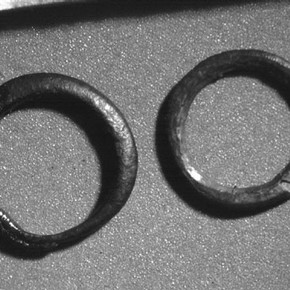
Figure 2b. Left an original link diameter 7mm. Right a new solid link stamped VA. Photography by S Metcalf (click image for larger version)
In situ Documentation and Repair
To document and identify each new ring on the object, they were stamped with the logo 'VA'. It was not possible on this occasion to add a date stamp though generally this is good practice. The links were then blackened by annealing to blend in with the original links. Finally the new links were used to repair the arm guard in conjunction with the original links. As each new link is marked, close inspection easily reveals (Figure 3) which links are repairs undertaken at the Museum. With such marking, future study is not compromised. If at a later date the repair is deemed to be unacceptable the links can be easily removed.
Conclusion
The use of stamped identification marks and where possible, a manufacture date, to new repairs on historic objects is important. The technique allows the physical repairs necessary for the preservation of an object to be undertaken without compromising further historical study. Such marking goes some way to solving the problem that the documentation of treatments can become separated from the object that they describe.
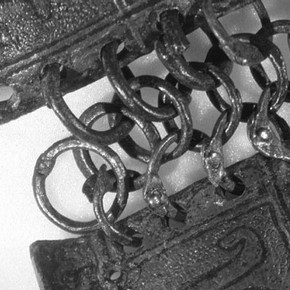
Figure 3. Detail of arm guard after treatment. New links marked VA are identifiable under close inspection. Photography by S Metcalf (click image for larger version)
Acknowledgements
I would like to thank Ian Ashdown of the Ashdown Centre of Conservation & Restoration, Onnens Switzerland, for his early encouragement and advice on the subject of mail armour during my internship with CCR in 1992. David Edge of the Wallace Collection for supporting this internship and Dr Alan Williams for his help and encouragement concerning metallography in general and on this object in particular.
References
1 Mail has been in use in the East for over 2000 years, mail and plate together, from probably before the C.14th.
'Oriental Armour', Robinson H. R., Herbert Jenkins Ltd, London 1967, p 10 -14.
2 The basic methods of construction for mail are described in 'The mail makers technique', Burgess E.M.,
The Antiquaries Journal, London 1953, Vol. xxxiii, pp 48-55, 193-202. Indian mail though different in
many respects, conforms generally to the details in these articles about European mail.
3 The author is engaged in the study of both the technology and dating of mail. Unpublished lecture from
'The Armourer & his Craft, The Worshipful Company of Armourers & Braziers, London 1997'.
4 The dating, translation, and historical research was done by A. S. Melikian-Chirvani and S. Stronge in
'The Arts of the Sikh Kingdoms, Ed. Stronge, S., V&A 1999, p 86, plate 94, p.213'.
5 Shah Shujar, reign 1803-9 and 1839-42, the arm guard is earlier in date but this does not precluded it from
being part of his armoury. See A. S. Melikian-Chirvani and S. Stronge above.
6 S. D. Metcalf examination, November 1992. Mary Rose reserve collection stores. Several brass borders
from mail armours have survived, the iron parts having corroded away.
7 S. D. Metcalf examination, December 1997.Royal Armouries inventory numbers III-7, III-40, III-42 and
others all in store
8 A solid link which had broken in two but had been retained by being stuck to a plate by the old lacquer coating was examined by the author and Dr A Williams using metallographic analysis.
9 There has been controversy about the manufacture of solid links of mail since 1959. 'Methods of making chain mail- a metallographic note, Stanley Smith C., Technology & Culture 1959, Vol. 1, pp 60-67' and 'A
reply to Cyril Stanley Smith on mail making methods, Burgess E M., Technology & Culture, 1960 Vol. 1
no2, pp 151-155'. The metallographic analysis of the V&A link is the first from this late date and country to be examined, and is unusual in being made from sheet and probably punched rather than hammer welded wire.
Spring 2001 Issue 37
- Editorial - Size Matters
- The Treatment of Mail on an Arm Guard from the Armoury of the Shah Shuja: Ethical Repair and in situ Documentation in Miniature
- Management of Large Objects at the Science Museum, Wroughton
- Digital Weightlifing and the Conservation of Large, Heavy Objects
- Four Terabytes and Counting
- Colour Changes for the V&A Facade
- Review of 'Gilding: Approaches to Treatment' UKIC Gilding Section Conference
